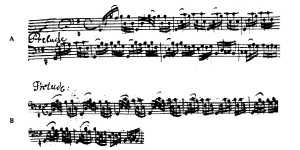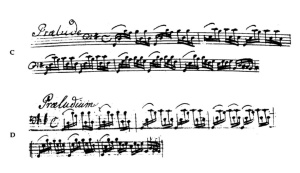The Cello Suites and Mrs Bach
PhD researcher Nadya Markovska reflects on controversies of authorship and what this says about our attitudes to performance and composition: Bach’s Six Suites for Solo Cello (BWV 1007-1012) are among the most famous pieces in the canon of Western music. Recent claims by the Australian researcher Martin Jarvis about their authorship have become a media sensation, causing heated scholarly debates in normally restrained musicological circles. Jarvis claims that the Cello Suites were composed not by Johann Sebastian but by his second wife Anna Magdalena. He announced his ‘new insights’ some time ago, in 2006 to the media and in 2008 to the Bach community, whose immediate reaction was suspicion and disbelief.
Now, thanks in part to social media and a television documentary Jarvis’s claims are back in the news. Everybody seems to be talking about Mrs Bach, possibly the greatest composer we’ve never heard of. The release of the film Written by Mrs Bach in December 2014, based on Jarvis’s book with the same title, caused defensive reactions from acclaimed Bach scholars and performers. Judging from the passionate critical analyses of the case, it seems that this uproar in the academic circles speaks of a much deeper issue in music studies: musicologists are deeply uneasy about their own business. It is clear that Jarvis’s claim is untenable; he depends far too much on speculation (not a surprise given how little physical evidence of these pieces survives). What I find most surprising, however, is how vehemently Bach scholars refute such a poorly argued theory. Why do they take it so seriously? Why take such an angry tone in public?
Historical background
The Cello Suites are notoriously enigmatic. Despite of their enduring popularity, we know very little about their genesis. It is believed that they were composed around the 1720s, when Bach was working in Cöthen under the patronage of Prince Leopold. Many of Bach’s works from this period, including the Cello Suites, share exceptional signs of technical and musical excellence. Among them is the set of Six Sonatas and Partitas for Solo Violin (BWV 1001-1006), against which many researchers judge stylistic and expressive aspects of the Cello Suites. An original score of the Sonatas and Partitas survives. But the original composer’s score of the Cello Suites has never turned up. Instead, we know them via four different manuscript copies (scholars call them Sources A, B, C and D). These were made at different points in the eighteenth century by four different copyists. Two of the copies date from Bach’s time. The earliest is from 1726 (Source B) and was prepared by the organist Johann Peter Kellner (1705-1772), one of Bach’s acquaintances. The copyist of the other one (Source A) was Bach’s wife, Anna Magdalena (1701-1770) – indeed, the note on the score ‘ecrite par Madame Bachen Son Epouse’, which was added by Georg Heinrich Ludwig Schwanenberger, is Jarvis’s point of departure, which he translates as ‘written by Madame Bach’. The other two copies (Sources C and D) were made later, in the second half of the eighteenth century. Although they have nothing to do with the composer directly, they demonstrate continued interest in the Suites at a time when Bach was by no means well known. All the four sources suggest different expressive readings of the music.
Four copies of the opening of the First Suite for Violoncello Solo (BWV 1007)
The most striking difference in all these sources is their free treatment of articulation. The earlier ones are inconsistent, even ‘erratic’. The later ones are more regular. Anna Magdalena’s bowings are the most varied. Overall, the layout of her copy is neat and clear, suggesting that she handled the job with care. But many musicians, and most scholars, find her articulations unusable (in his article on the Jarvis controversy the acclaimed British cellist Steven Isserlis calls her copy ‘error-ridden’). They make the music look amorphous and unsymmetrical – certainly not what we would expect from J.S. Bach, whose music has long been celebrated for its perfect intellectual geometry. Among performers, the legendary Dutch baroque cellist Anner Byslma has long been one of the only ones to take Anna Magdalena’s articulations seriously, and performed them for decades in public.
The crux of the argument
To return to the current controversy: the core question is about authorship. One name – either J. S. Bach or, in Jarvis’s case, Anna Magdalena – needs to bear the responsibility of providing the authoritative, exemplary reading we, music scholars, feel duty bound to preserve and reproduce. And that’s the problem: if we insist that every claim has to based on proven fact, there is no evidence to prove either of the two options. To put it another way: Jarvis’s argument may be very thin, but his opponents shouldn’t forget that there is no score of this music in J.S. Bach’s hand, and therefore no positive proof that he was its composer.
The case is seemingly unsolvable. Why not look at it then, from a different perspective? Instead of searching for a single authoritative source, the ‘right’ version, one that will automatically exclude the other sources as ‘wrong’, I think that each of those readings reflects an interesting suggestion of how the pieces could be played. I view this rich variety of interpretations as a reminder of something crucial, and often forgotten, about the music of this time: its flexibility to adapt to the needs of its performers and audiences. Like all of Bach’s music, the Suites document Bach’s search for the ‘right notes’, but also the aesthetic needs of communities of his listeners. Anna Magdalena was a talented singer, recognised as professional chamber musician in the court of Prince Leopold of Anhalt-Cöthen. She was paid a salary there nearly equal to that of her husband. As a professional musician, her reading of the Suites could be her own version how the music should be played. Her ‘unregularised’ articulation seems ‘wrong’ in the context of our current expectations for consistent and symmetrical musical structures.
If, however, we place her reading in the context of the performance traditions of early-eighteenth-century professional music circles, we might see it from a different angle. The key analogy is speech. Hundreds of books on rhetoric from the early eighteenth century and before enjoin readers to take account of their audience when trying to convince them of something. Anna Magdalena’s articulations reveal an exhaustive exploration of the potential of excellent bow technique to discover as many expressive variants of a single melodic model as possible. I do not assert that her reading of the music is the ‘right’ one, just that it could be one of many possible ways to read and explore further Bach’s initial musical invention.
I think that not having a definitive answer, based on firm evidence, is a good thing. Bach’s original musical idea remains open, and will continue to challenge the creative thinking of generations ahead. And isn’t this what Bach probably aimed for? To compose music that will live on, and challenge, after he is gone? Isn’t it better for today’s performers and listeners (and musicologists!) to come to this music on our own terms, instead of trying to keep it preserved in a fixed (sacred) version? This joy of rediscovery and re-reading is what all four early copyists of the Suites reflected in their manuscripts. If only we had such flexibility! Then we could stimulate many more fruitful experiences for performers and audience alike in this already familiar repertoire.
And one more thing. If the pieces – their architecture, their thrilling re-interpretations of dance forms, their acrobatically hidden harmonies – are by Mr Bach, that’s fair enough. But if the expressive surface on Source A is by Mrs Bach, and we take this copy seriously, then she does get to keep at least a little of the credit.
This post is based on the research for my PhD thesis (‘Bach’s Suites for Solo Cello (BWV 1007-1012) and the Textual Geographies of Modernity’) at the University of Southampton.



